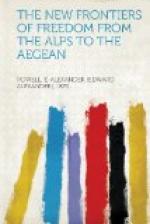In discussing the question of Fiume the mistake is almost invariably made of considering it as a single city, whereas it really consists of two distinct communities, Fiume and Sussak, bitterly antagonistic and differing in race, religion, language, politics, customs, and thought. A small river, the Rieka, no wider than the Erie Canal, divides the city into two parts, one Latin the other Slav, very much as the Rio Grande separates the American city of El Paso from the Mexican town of Ciudad Juarez. On the left or west bank of the river is Fiume, with approximately 40,000 inhabitants, of whom very nearly three-fourths are Italian. Here are the wharfs, the harbor works, the rail-head, the municipal buildings, the hotels, and the business districts. But cross the Rieka by the single wooden bridge which connects Fiume with Sussak and you find yourself in a wholly different atmosphere. In a hundred paces you pass from a city which is three-quarters Italian to a town which is overwhelmingly Slav. There are about 4,500 people in Sussak, of whom only one-eighth are Italian. But let it be perfectly clear that Sussak is not Fiume. In proclaiming its annexation to Italy on the ground of self-determination, the National Council of Fiume did not include Sussak, which is a Croatian village in historically Croatian territory. It will be seen, therefore, that Sussak, which is not a part of Fiume but an entirely separate municipality, does not enter into the question at all. As for the territory immediately adjacent to Fiume on the north and east, it is as Slav as though it were in the heart of Serbia. To put it briefly, Fiume is an Italian island entirely surrounded by Slavs.
The violent self-assertiveness of the Fumani may be attributed to the large measure of autonomy which they have always enjoyed, Fiume’s status as a free city having been definitely established by Ferdinand I in 1530, recognized by Maria Theresa in 1776 when she proclaimed it “a separate body annexed to the crown of Hungary,” and by the Hungarian Government finally confirmed in 1868. Louis Kossuth admitted its extraterritorial character when he said that, even though the Magyar tongue should be enforced elsewhere as the medium of official communication, he considered that an exception “should be made in favor of a maritime city whose vocation was to welcome all nations led thither by commerce.”




